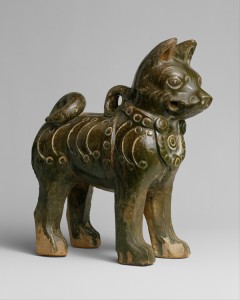The Met’s Year of the Dog
May 29, 2018
In 2018, the Metropolitan Museum of Art in New York City is marking the Year of the Dog, the 11th year of the 12-year cycle of the Chinese zodiac (also called the Eastern or East Asian zodiac). A special exhibition called “Celebrating the Year of the Dog” presents remarkable canine-themed works in the museum’s Arts of Ancient China gallery. The exhibit, which began January 19 and runs through July 4, illustrates the close ties between dogs and people during the Later Han dynasty (A.D. 25-220) of ancient China.

The “Celebrating the Year of the Dog” exhibit includes this ancient glazed pottery figure of a dog. The earthenware canine was part of a funerary tribute to keep a person company in the afterlife. Credit: Figure of a Dog [Eastern Han dynasty (25–220)], earthenware with dark green glaze; Metropolitan Museum of Art
The Chinese zodiac is a cycle of 12 animal signs used in a system of astrology practiced in China, Korea, Japan, Taiwan, and other Asian countries. This system assigns an animal sign to represent each lunar year. A lunar year is a year measured by tracking phases of the moon, rather than changes in the sun’s position in the sky. Each animal sign represents an entire year, and the cycle repeats every 12 years. The 12 animal signs are, in order, the rat, ox, tiger, rabbit (or hare), dragon, snake, horse, goat (or sheep), monkey, rooster, dog, and pig (or boar).

In Chinese culture, a dog entering a house is sign of good fortune. Dogs were thought to guard a house against evil spirits, as well as more tangible threats such as thieves or wild animals. This Irish setter would surely bring someone good fortune. Credit: © Dreamstime
Dogs, which have been loyal human companions for thousands of years, first became associated with the Chinese lunar calendar in the 200′s B.C. By the A.D. 100′s, nearly all eastern zodiacs included dogs in the cycle. Each zodiac animal is associated with the character traits of people born during that animal’s year. People born in the Year of the Dog are thought to be active, loyal, and vigilant. Subtract 12 from 2018, and you will know if you were a dog year baby (2006 or 1994, for example). In 2018, the Year of the Dog began on February 16, and it runs through Feb. 4, 2019, when it gives way to the 12th and final year of the Chinese zodiac cycle, the Year of the Pig.
In China, archaeological evidence indicates that dogs—both real and artistic representations—were buried to accompany deceased humans as early as the Shang dynasty (about 1766 B.C. to about 1045 B.C.). By the time of the Later Han dynasty, dogs were commonly represented in metalwork, painting, and pottery. Dogs have remained popular artistic subjects—and pets—in China ever since.


